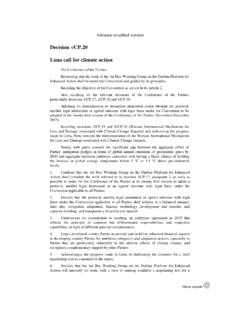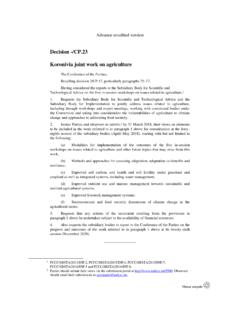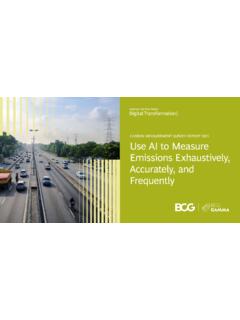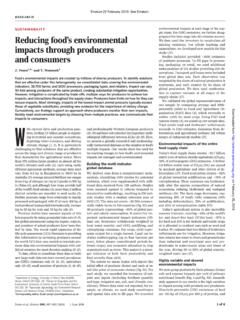Transcription of Sweden’s long-term strategy for reducing greenhouse gas ...
1 Sweden s long-term strategy for reducing greenhouse gas emissions December 2020 Ministry of the Environment 2 (87) Index 3 1 Introduction .. 7 2 Sweden s climate policy framework .. 9 Sweden s national climate goals .. 9 Sweden s Climate Act .. 12 A Climate Policy Council .. 13 3 Sweden s current conditions and emissions .. 15 National situation .. 15 Sweden s greenhouse gas emissions and removals .. 17 Energy .. 25 Digitalisation .. 30 Climate change adaptation .. 30 4 Action areas and instruments .. 35 Instruments work together to attain Sweden s climate goals .. 35 Cross-sectoral, overarching policy instruments .. 36 Transport .. 43 Industry .. 51 Electricity and district heating.
2 56 Households and services .. 60 Non-road mobile machinery .. 65 67 Agriculture .. 71 Land use, land use change and forestry, LULUCF .. 74 5 Consequences of Sweden s goals and actions .. 79 Consequences of failing to meet the climate targets .. 79 Consequences of Swedish policy to attain the climate goals .. 80 6 Buy-in and realisation Sweden s path to goals and measures 83 Annex 1 Modelling .. 86 Ministry of the Environment 3 (87) Summary Purpose Long term strategies shall contribute to fulfilling Parties commitments under the UNFCCC and the Paris Agreement to reduce anthropogenic greenhouse gas emissions and enhance removals by sinks, and to promote increased carbon sequestration. Reporting concerns national long-term objectives for territorial emissions .
3 This document constitutes Sweden s reporting and derives from Sweden s existing targets, and policy instruments and actions decided on in the field of energy and climate. The strategy is largely based on the national climate policy framework and Government Bill1 En samlad politik f r klimatet klimatpolitisk handlingsplan (A coherent policy for the climate climate policy action plan). The Swedish Climate Policy Framework Under the Paris Agreement, all countries are to contribute towards holding the increase in the global average temperature to well below 2 C and pursuing efforts to limit the temperature increase to C. This demands wide-ranging action to reduce greenhouse gas emissions and also demands that every sector of society plays a part in the climate transition.
4 In 2017, the Swedish Parliament (Riksdag) adopted a climate policy framework with (1) national climate goals, (2) a Climate Act and (3) a Climate Policy Council. The climate policy framework s long-term climate goal establishes that, by 2045 at the latest, Sweden is to have zero net emissions of greenhouse gases into the atmosphere and should thereafter achieve negative emissions . By 2045, greenhouse gas emissions from Swedish territory are to be at least 85 per cent lower than emissions in 1990. To achieve net zero emissions , supplementary measures may be counted in line with rules decided at international level. Supplementary measures may be (1) increased net removal of carbon dioxide in forests and land, (2) verified emission reductions from investments in other countries, and (3) negative emission technologies such as capture and storage of biogenic carbon dioxide (BECCS).
5 Milestone targets for Swedish territorial emissions in the sectors covered by the EU s Effort Sharing Regulation have been adopted for 2020, 2030 and 2040, see Figure 1. emissions from domestic transport, excluding domestic 1 Prop 2019/20:65 Ministry of the Environment 4 (87) aviation which is included in the EU ETS, are to be reduced by at least 70 per cent by 2030 compared with 2010. Figure 1. Sweden s climate targets (with and without the opportunity to use supplementary measures) and historical emissions Sweden s Climate Act imposes an obligation on current and future governments to pursue a policy based on the national climate goals. The Act contains elements that ensure that the policy is planned and followed up.
6 Sweden s Climate Policy Council is an independent expert body tasked with evaluating whether the overall policy decided by the Government is compatible with the climate goals. The EU s climate policy has a major impact on how Swedish policy can be conducted. The EU's current climate target is to cut greenhouse gas emissions by at least 40 per cent in the EU by 2030 compared to 1990. In September 2020 the European Commission presented its 2030 Climate Target Plan which proposed to increase the target to at least 55 per cent. The EU's heads of state and government are expected to endorse such an enhanced target at the end of 2020. The emissions covered are territorial and do not include the emissions that the EU causes outside the EU s borders.
7 A number of policy instruments at EU level, including emission standards for vehicles and emissions trading are very important to Sweden s possibility to meet its own national targets. 0102030405060708019901995200020052010201 5202020252030203520402045Mt CO2 eqSweden emissions within EU ETS ESR National net zero target for Sweden s total emissions by 2045 Targets for non-trading sectors Net negative emissions after 2045 Ministry of the Environment 5 (87) Sweden uses a number of national and EU-wide policy instruments to meet the national climate goals. emissions pricing forms the basis of governance and is supplemented by targeted initiatives. The policy instruments in Sweden and the EU span all sectors of society. It is estimated that they will help to achieve the targets but that further measures will be needed to fully attain them.
8 Areas of possible actions to attain the long-term climate target have been identified in the respective sectors. Government spending on climate related initiatives has increased substantially in recent years. Table 1. Overview of key policy instruments and measures impacting on the national climate targets (EU instruments are marked with an asterisk) Transport Industry Electricity and district heating Homes and premises Non-road mobile machinery Waste Agriculture LULUCF Energy and carbon tax Emission reduction targets for new vehicles* Reduction obligation Bonus-malus system Tax reduction for eco-friendly cars carbon dioxide-based vehicle tax Klimatklivet (local investment grants) Climate premium Act on the Obligation to Supply Renewable Fuels Energy and carbon tax EU ETS* Industriklivet (the Industrial Leap) Energy and climate coaches Energy surveys for companies Energisteget (energy efficiency grants for industry)
9 Energy efficiency networks Klimatklivet (lthe Climate Leap) Environmental Code EU Regulation on fluorinated Energy and carbon tax EU ETS* The Electricity Certificate System Promoting wind power Support for solar energy Tax reduction for microproduction of renewable energy Energy and carbon tax Eco-design Directive* Energy Labelling Directive* Building regulations Training programme for low energy buildings Energy and climate advice Energy declarations* Market launch, technology development, innovation clusters Information centre for sustainable Energy and carbon tax Reduction obligation Procurement requirements Ban on combustible and organic waste in landfill Collection of methane from landfill Waste hierarchy in the Environmental Code Landfill tax Producer responsibility Municipal waste planning CAP* Aid for manure gas Forestry Act Environmental Code rules on land drainage Protecting forest and land in the Environmental Code and nature conservation agreements The National Forest Programme Advice and training Ministry of the Environment 6 (87) Urban environment agreements long-term infrastructure planning Eco bonus for shipping Tax on air travel EU ETS (aviation)
10 * greenhouse gases construction The costs related to climate change and the cost of failing to act will be very high. Several reports2 have shown that the costs of not taking action widely exceed the costs of doing so. The economic consequences of national policy to attain Sweden s national climate goals are hard to calculate. Many of the consequences will depend on how Sweden reaches the goals and under which conditions. In recent decades, Sweden has succeeded in combining reduced emissions with strong economic development. A long-term and stable climate policy is needed if Sweden is to lead the way on a global transition. A broad parliamentary majority backs the decision made in 2017 on the climate policy framework.

















